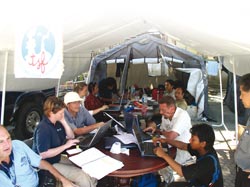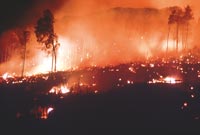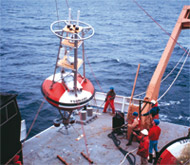
| Home : ITU News magazine | |||||||||||||||||||||||||||||||
PPDR radiocommunication systems must be designed to meet several broad objectives. As well as providing vital means of communication in emergencies and disasters in each country, their other aim is to promote interoperability between cross-border networks, to make it easier for countries to cooperate in providing effective and appropriate humanitarian assistance when required. This means that when planning radiocommunication services for public safety agencies and organizations, it is necessary to take account of advanced services that will require higher data rates, along with video and multimedia capability, in addition to the voice applications commonly used now. These advanced applications include ways to access the types of background information that may be needed quickly when responding to an emergency. As PPDR operations become more reliant on electronic databases and data processing, access to accurate and detailed data by staff in the field, such as police, firefighters and medical emergency personnel, is critical to improving their effectiveness. This information is typically held in office-based database systems and includes images, maps and architectural plans of buildings. The flow of information back from units in the field to operational control centres is equally important. During an emergency, authorities are required to make critical decisions that are affected by the quality and timeliness of information received from the field. In 2000, the World Radiocommunication Conference (WRC-2000) approved Resolution 645, inviting ITU–R to conduct studies with a view to harmonizing spectrum globally or regionally for these advanced solutions for public protection and disaster relief. WRC-2000 also called for studies to determine the technical and operational basis for global cross-border circulation of radiocommunication equipment in emergencies. The needs of developing countries for low-cost solutions are also recognized in Resolution 645. Forging an agreementITU’s global effort to harmonize PPDR communications is well documented in ITU–R Report M. 2033. The report defines the public protection and disaster relief objectives and requirements for implementing advanced solutions to meet the operational needs of PPDR agencies by 2010. It highlights the results of ITU–R’s studies in the run-up to WRC-03. These results, together with the salient sections of the Report of the Conference Preparatory Meeting, provided the technical basis for WRC-03 to discuss PPDR issues. There was widespread interest in this agenda item, which called on WRC-03 “to consider identification of globally/regionally harmonized bands, to the extent practicable, for the implementation of future advanced solutions to meet the needs of public protection agencies, including those dealing with emergency situations and disaster relief, and to make regulatory provisions, as necessary, taking into account Resolution 645 (WRC-2000)”. For many countries, globally harmonized frequency bands for the use of PPDR applications was seen as a priority because of the potential to offer the benefits of economies of scale. But many others held the view that such global harmonization was unnecessary, since the organizational responsibilities for public protection and disaster relief activities are matters for administrations to determine at the national level. And a third group of countries argued that new radiocommunication technologies, including software-defined radios and commercial mobile services such as IMT-2000 networks, should also be used to meet the needs of PPDR agencies. A further complication was the fact that PPDR agencies at the time of WRC-03 were largely reliant on traditional voice applications scattered over a wide range of frequency bands, usually in the VHF and UHF ranges of the spectrum. In view of the bandwidth requirements for the advanced solutions being contemplated for PPDR, and without any sign of a uniform approach to the use of frequency bands, it looked unlikely that a global solution on spectrum harmonization would emerge from the conference. Resolution 646 on public protection and disaster reliefHarmonization: While no common global band could be identified by WRC-03, an important breakthrough was the adoption of Resolution 646, which lists specific frequency bands and ranges that governments should consider when undertaking their national planning for PPDR. These bands are listed separately for each of the three ITU regions: Region 1 (Europe and Africa), Region 2 (the Americas) and Region 3 (Asia and Australasia).
Resolution 646 strongly recommends that countries should use the harmonized bands identified for use in each region for public protection and disaster relief, taking into account national and regional requirements. They are also requested to encourage PPDR agencies to use relevant ITU–R Recommendations in planning spectrum use and when implementing technology and systems to assist in the agencies’ work. The benefits of spectrum harmonization, even though restricted to a regional rather than a global level, include increased potential for interoperability in PPDR activities. It is also expected to create a broader manufacturing base, leading to economies of scale and cheaper, more readily available equipment. This, in turn, will give PPDR agencies better access to enhanced system capabilities built on uniform types of equipment. Ultimately, the winners will be the people whom the agencies serve at times of disaster. Cross-border sharing: Resolution 646 also acknowledges the contributions of national and international humanitarian organizations in providing radiocommunications after large-scale disasters. Administrations are urged to facilitate cross-border sharing of radiocommunication equipment that is intended for use in emergencies and for disaster relief. Regulatory barriers have often made it difficult for humanitarian organizations to import and use telecommunication equipment across borders. To help address this problem, ITU played an active role in drafting the Tampere Convention on the Provision of Telecommunication Resources for Disaster Mitigation and Relief Operations, which came into force on 8 January 2005, following its ratification by 30 countries. It is hoped that victims of disasters will now be able to benefit from faster and more effective rescue operations, thanks to the convention. New technologies: Resolution 646 also says that administrations should encourage PPDR agencies to employ both existing and new technologies and solutions to satisfy interoperability requirements. This could also include the use of advanced wireless solutions where appropriate, to provide complementary support to PPDR activities. The resolution highlights the example of a joint standardization project between the European Telecommunication Standards Institute (ETSI) and the United States Telecommunications Industry Association (TIA), known as Mobility for Emergency and Safety Applications (MESA). The goal of MESA is to develop advanced mobile broadband technical specifications that can be used to support the communication requirements of PPDR agencies. Another platform for coordinating harmonized standards is the Telecommunications for Disaster Relief (TDR) Partnership Coordination Panel, established under the auspices of ITU with the participation of governments, international telecommunication service providers, standards development organizations and disaster relief agencies. Finally, Resolution 646 directs comments towards the manufacturers of PPDR systems and equipment. They are encouraged to take the resolution into account when designing equipment, and to consider the need for countries to operate within different parts of identified frequency bands.
Work continuesWRC-03 reached a conclusion on the spectrum requirements for PPDR, and also concluded that there was no need to place this topic on the agenda of a future conference. Nevertheless, it did recognize that studies are still needed in some areas and it requested ITU–R:
Since WRC-03, studies have continued within Working Party 8A of ITU–R. These studies have focused on preparing a recommendation on a narrow-band application that uses data communication for the protection and tracing of property. A draft recommendation “Harmonized frequency channel plans for the protection of property using data communication” was considered by Study Group 8 at its meeting in November 2005. Additional studies in Working Party 8A are expected to result from work now under way in some countries in Region 1 on requirements for wide-band and broadband PPDR applications. As well as the studies on PPDR, there are other programmes within ITU–R related to disaster relief operations. The humanitarian activities of amateur radio and amateur satellite services are highlighted in Recommendation ITU–R M.1042, which encourages the development of networks within these services that are capable of providing communications during disasters and relief operations. Moreover, Working Party 8D is developing a recommendation on applications in the mobile satellite service for disaster relief operations, while Study Groups 6 and 7 are working on systems to be used in support of disaster prediction and detection and for communicating warnings and alerts.
The needs do not diminishAround the world, the radiocommunication needs of PPDR users are not diminishing; they are growing at a rapid rate. The longer public safety agencies have to wait for effective PPDR solutions supporting advanced applications, the longer the current, ad hoc, uncoordinated and at times uneconomic approach will continue. Through the decisions reached at WRC-03, ITU–R is working to resolve implementation issues in support of PPDR users as they discharge their responsibilities for humanitarian assistance and the restoration of normal life following disasters of every type.
|
|||||||||||||||||||||||||||||||
 Radiocommunication for public protection and disaster relief
Radiocommunication for public protection and disaster relief





